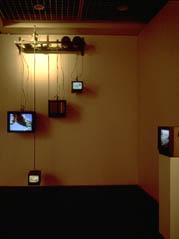
|
| Technical Details: 5 monitors,
metal, cables, mechanical parts |
|
There is still no conclusive neuro-biological or psychological explanation for the functioning of memory and recollection. Is our memory a well-ordered and inexhaustible archive, which, leaving no gaps, preserves the past in pinpoint-sharp, 'true', images? Or rather, is it an unstructured potpourri of more or less diffuse impressions, which only assume a representable form and meaning through a topical moment, and therefore not through the past to which they refer? In how far do our memories really correspond with reality as it once occurred?
In the era of technological reproducibility, there are, beside our own individual and collective memories, other storage, registration and representation media, such as, film, television and the Internet, which also 'report' on life and together constitute an entirely new, artificial, memory. In how far does this new memory influence our own memories? If you recall a certain moment from the past, for example, your sixth birthday, do you then actually remember this event from long ago, or rather the images from the Super-8 film made of it? Or is it thanks to this film that you remember it?
Have our brains perhaps partly adopted the language of film, including flashbacks, overlaps, fades and slow-motion, to form memory images? In Witness, Fiona Tan took the specific relationship between cinematic representation and manipulation of time, and our own perception and memory, as a starting point. Tan asked herself whether our "subjective perception of time has been changed by television and film, or whether these media are the embodiment of memory".
The title of this installation refers to an investigation of witness testimonies on the 1992 air disaster in the Bijlmer district in Amsterdam: an aeroplane crashed on a block of flats, resulting in a large number of casualties. Many witnesses described the fatal incident as if it were a TV recording, which, however, does not exist in reality. The picture imagined turns out to be as 'true' as what the witnesses actually saw.
As a basis, Tan took an anonymous five-second film fragment of an accident recorded during a car race in 1924. To Tan, this coincidental and brief registration, with its high degree of 'immediacy', represents the essence of the medium of film and the super-fast technological developments of this century. She combined this historical fragment with her own video footage, in which she experimented with various forms of time montage and, in an associative manner, referred to the images from the old film fragment, of the driver being sent flying out of his racing car and falling back to the ground.
Facing a monitor which shows the original film footage, four hanging monitors show images, each of a different format, and each referring to units of time: frame, second, minute, hour and day. Each video shows a different camera position, a different cut and a different subjective perception of time, but together they form a whole and can be seen as the dissection of a moment. Time and movement also find expression in the interplay of installation and space: the monitors are hung on cables which move independently from each other as components in a clockwork mechanism. Witness shows an incident and the passing of time from a multitude of perspectives without an absolute or central point of calibration. Once it has been committed to your memory, its reconstruction can start again.
Jorinde Seijdel
|
|
